In the world of drumming, technology has become a game-changer, transforming the way drummers learn, practice, and perform. Gone are the days of tedious practice sessions spent struggling to read sheet music or decipher complex rhythms on their own when a teacher can’t be present. Modern technology has made it easier than ever for drummers to hone their skills, expand their musical knowledge, and take their craft to new heights.
A revolutionary development is the advent of smart drumming apps. Apps like Drummer’s Helper, Rhythm Lab, and Time Trainer provide access to a vast library of songs, exercises, and rudiments, all at the drummer’s fingertips. These apps enable drummers to practice along with their favorite songs, develop their skills, and even connect with other drummers worldwide. Most notably in this article, I’ll be highlighting a new app called Beatnote available in the apple store. (Coming to Android soon)
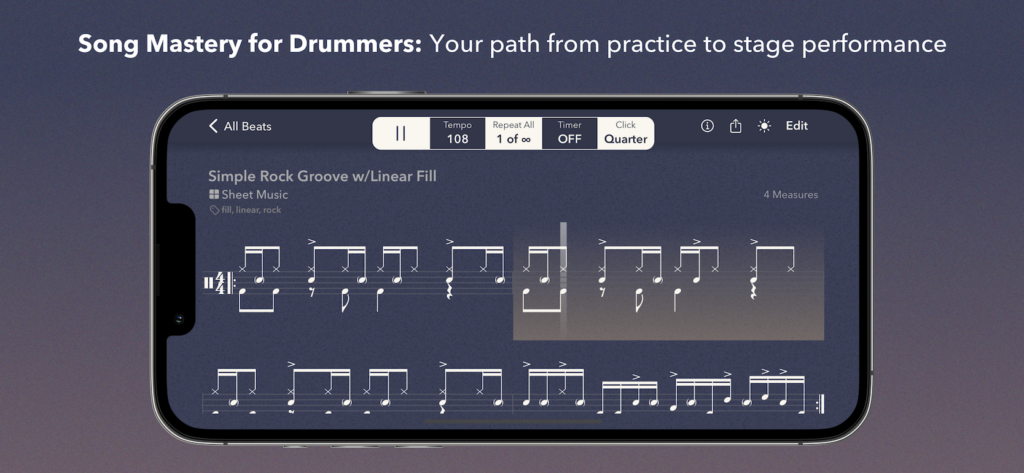
Technology has made it easier for drummers to learn, read, and write music. Software like Beatnote, Finale, Sibelius, Sound Slice, and MuseScore enable drummers to create, edit, and print sheet music with ease. These programs also offer tools for notation, transcription, and analysis, making it simpler for drummers to understand complex rhythms and time signatures.
In conclusion, modern technology has transformed the drumming landscape, offering a wealth of innovative tools where now, instructors and students can work together with these innovative apps to help students learn, absorb absorb information and put to good use the resources that enhance learning, practice, and performance. With the aid of digital software, smart apps, and music notation programs, drummers can now unlock their full potential, pushing the boundaries of rhythm and creativity. Embrace the beat of innovation and discover the exciting possibilities that technology has in store for drummers!
Enrolling kids in summer music programs can have a multitude of benefits that extend far beyond just learning to play an instrument. At Freeway Music, these programs offer a unique opportunity for children to explore their creativity, develop discipline, and enhance their cognitive abilities. Here are some key reasons why summer music programs are important for kids:
- Creativity and self-expression: Music is a powerful form of self-expression, allowing children to convey emotions, thoughts, and feelings in a creative way. By enrolling in a music program, kids can tap into their creative potential and explore different genres and styles of music.
- Cognitive development: Learning music has been shown to have a positive impact on cognitive development. It can improve memory, enhance mathematical skills, and increase spatial-temporal skills. Music also helps children develop critical thinking and problem-solving abilities.
- Discipline and perseverance: Mastering a musical instrument requires dedication, practice, and perseverance. By enrolling in a summer music program, kids learn the value of hard work, discipline, and patience. These qualities can transfer to other areas of their lives, helping them excel academically and professionally.
- Social skills and teamwork: Many summer music programs involve group activities, such as playing in a band or orchestra. These experiences teach children valuable social skills, such as collaboration, communication, and teamwork. Kids learn to listen to each other, compromise, and work together towards a common goal.
- Confidence and self-esteem: As children develop their musical skills and see their progress over the course of a music program, their confidence and self-esteem grow. Performing in front of an audience, whether it’s a small group of parents or a larger concert hall, can help kids overcome stage fright and build confidence in themselves.
- Cultural appreciation: Music is a universal language that transcends cultural boundaries. By enrolling in a music program, kids have the opportunity to explore music from different cultures and time periods. This can broaden their perspectives, foster appreciation for diversity, and spark a lifelong love of music.
Overall, enrolling kids in music programs, especially starting in the summer, when they have less on their plate, can have a lasting impact on their personal, social, and academic development. Whether they continue to pursue music as a career or simply enjoy it as a hobby, the benefits of music education are undeniable. If you have the chance to enroll your child in a summer music program, seize the opportunity to help them unlock their full potential and foster a lifelong passion for music.
Music education has long been touted as a valuable tool for children’s cognitive, social, and emotional development. But just how impactful is it? In this article, we’ll explore the numerous benefits of music education for children, backed by credible studies and research.
Cognitive Benefits:
* Improved memory and spatial-temporal skills (Rauscher et al., 1998)
* Enhanced language development and literacy skills (Forgeard et al., 2008)
* Better math and reading skills (Hetland & Winner, 2001)
Social-Emotional Benefits:
* Improved social skills and teamwork (Hallam, 2010)
* Reduced stress and anxiety (Kruger & Schechter, 2017)
* Enhanced creativity and self-expression (Boden & Mayer, 2009)
Brain Development:
* Increased grey matter volume in auditory and motor areas (Schlaug et al., 2005)
* Stronger neural connections and plasticity (Kraus & Chandrasekaran, 2010)
Conclusion:
The evidence is clear: music education gives children a significant jumpstart in life. By introducing music education early on, parents and educators can help shape young minds, foster creativity, and set the stage for future success. At times, when you’re in the moment- it may feel as though progress is slower than you would expect, but it’s important to remember, music education like anything else, takes time to understand, master and produce results. If we allow ourselves opportunity to enjoy the process, the results will surprise you in such an amazing way.
Sources:
Boden, M. A., & Mayer, R. E. (2009). Music and the Mind. Scientific American, 300(6), 72-77.
Forgeard, M., Winner, E., & Schlaug, G. (2008). From singing to speaking: Facilitating recovery from non-fluent aphasia using melodic intonation therapy. Annals of the New York Academy of Sciences, 1145, 243-254.
Hallam, S. (2010). The impact of music education on cognitive development in children. Journal of Research in Music Education, 58(3), 270-282.
Hetland, L., & Winner, E. (2001). The arts and academic achievement: What the research shows. Arts Education Policy Review, 102(5), 3-6.
Kraus, N., & Chandrasekaran, B. (2010). Music training for the development of auditory skills. Nature Reviews Neuroscience, 11(8), 623-630.
Kruger, J., & Schechter, J. (2017). The impact of music education on stress and anxiety in children. Journal of Music Therapy, 54(2), 147-162.
Rauscher, F. H., Shaw, G. L., & Ky, K. N. (1998). Music, cognition, and emotion: A review of the research. Psychology of Music, 26(1), 73-92.
Schlaug, G., Marchina, S., & Norton, A. (2005). From singing to speaking: Facilitating recovery from non-fluent aphasia using melodic intonation therapy. Annals of the New York Academy of Sciences, 1060, 243-254.
Learning to play a musical instrument is a journey filled with excitement, challenges, and, most importantly, patience. For children embarking on this adventure, the concept of patience might seem elusive amidst their eagerness to master the instrument quickly. However, understanding the importance of patience in this process is essential for both parents and educators alike.
Patience serves as the cornerstone of a child’s musical development, fostering a positive and enriching learning experience. Rather than focusing solely on achieving immediate results, cultivating patience allows children to embrace the journey of learning an instrument, nurturing their creativity, and building a lifelong passion for music.
One of the key aspects of fostering patience in children learning a new instrument is encouraging them to “play” rather than “practice.” This subtle shift in language can have a profound impact on a child’s perception of the learning process. By framing their musical exploration as play, children are invited to approach the instrument with curiosity, imagination, and a sense of freedom. This mindset shift empowers children to explore the instrument at their own pace, experiment with different sounds, and express themselves creatively without the pressure of perfection.
Here are some practical tips for suggesting children to “play” rather than “practice” when learning a new instrument:
- Create a Playful Environment: Set the stage for musical exploration by creating a playful and supportive environment. Encourage children to view their instrument as a tool for creative expression rather than a daunting challenge.
- Embrace Mistakes as Learning Opportunities: Help children understand that making mistakes is an integral part of the learning process. Encourage them to embrace their mistakes, learn from them, and use them as opportunities for growth and improvement.
- Encourage Creativity: Foster a spirit of creativity by encouraging children to experiment with the sounds and techniques of their instrument. Provide them with opportunities to improvise, compose their own melodies, and explore different genres of music.
- Celebrate Progress, Not Perfection: Shift the focus from achieving perfection to celebrating progress. Recognize and celebrate each small milestone along the way, whether it’s mastering a new chord, playing a simple melody, or improvising a short tune.
- Be Patient and Supportive: Above all, be patient and supportive throughout the learning process. Encourage children to enjoy the journey of learning an instrument and reassure them that progress takes time.
By encouraging children to “play” rather than “practice,” we empower them to take ownership of their musical journey, make it their own, and develop a lifelong love for music. Through patience, encouragement, and a playful approach, we can nurture the next generation of musicians and inspire them to unlock their full potential.
Introduction:
In the symphony of a child’s development, music education plays a pivotal role, harmonizing cognitive, emotional, and social growth. As we delve into the orchestration of academic studies, it becomes evident that the influence of music on young minds goes far beyond the notes on a page. Let’s explore the symphonic journey of why music education is not merely a supplemental class but an essential element in the composition of a child’s holistic learning experience.
The Cognitive Crescendo:
Research from renowned institutions such as Harvard and Johns Hopkins has been tuning into the cognitive benefits of music education for years. The brain, akin to a musical instrument, undergoes a transformative tune-up when exposed to the intricacies of music. Studies suggest that children engaged in music education demonstrate enhanced cognitive skills, including improved memory, attention span, and problem-solving abilities.
One notable study, conducted at the University of California, found that children involved in music education showed accelerated development in the areas of language processing and mathematical reasoning. The rhythm and patterns inherent in music seem to create a neural symphony, fine-tuning the brain for more efficient cognitive processing.
The Emotional Overture:
Beyond the realms of academia, music education orchestrates a powerful emotional overture in the lives of children. It serves as a melodic refuge, providing an outlet for self-expression and emotional regulation. Music becomes the soundtrack to a child’s emotional journey, helping them navigate the complex tapestry of feelings.
A study published in the Journal of Research in Music Education discovered that children engaged in music education exhibited higher levels of empathy and emotional intelligence. The collaborative nature of playing in an ensemble cultivates a sense of camaraderie, teaching children the art of listening and responding to the emotions conveyed through music.
The Social Symphony:
In the grand performance of life, the ability to collaborate and communicate is key. Music education, with its emphasis on ensemble playing and group dynamics, becomes the rehearsal ground for these essential social skills. You will find resonance in the transformative power of music education to tip the scales in favor of positive social development.
Research from the National Association for Music Education highlights the social benefits of music education, noting that children engaged in musical activities develop a strong sense of teamwork, discipline, and leadership. The shared pursuit of musical excellence cultivates a sense of belonging, transforming classrooms into harmonious communities.
Conclusion:
In the symphony of a child’s education, music is not merely an optional chord but a fundamental note that resonates across the cognitive, emotional, and social dimensions. Let us acknowledge that the true crescendo of a child’s potential is orchestrated by the transformative power of music education. It’s not just about creating musicians; it is about sculpting minds that resonate with the harmonies of lifelong learning and emotional intelligence. The importance of music education, when understood in this comprehensive light, becomes a powerful testament to the enduring melody that shapes the future of our young minds.
If there’s anything to know about drummers, it’s that we’re loud, both behind and away from the kit. But there’s a time and place for noise, and a thin-walled apartment is not one of them. RTOM’s Black Hole mesh practice set is perfect for musicians who want to avoid a complaint for their neighbors and still jam out in the comfort of their own home.
These muted pads maintain the stiff feel of a drum set while producing a fraction of the sound. It’s so quiet that your neighbors wouldn’t even know you were playing unless they saw you. The tension of the mesh pad is adjustable, just like tuning a regular drum, so it can be looser or tighter depending on your preference. They’re also easy to install; you just pop them on top of your kit and start playing, no assembly required.
Of course, the high price will deter many, especially college-aged drummers on a budget. For professionals and anyone playing long-term, though, the investment will pay off in the long run. While they dampen noise, other cheap brands lie directly on the drums heads, meaning they still create more sound than some might be comfortable with. The Black Hole hovers above the drum pads themselves, holding on from the metal rim, meaning there’s no chance for any resonance to shake the drums and make more noise than necessary.
On top of that, the mesh maintains a greater surface tension that allows drumsticks to bounce off the same way they do a regular drumhead. Other mute pads made of foam or plastic tend to cushion them, slowing you down while you play and taking away the stick’s essential rebound that allows you to play faster. These foam pads also can tear easily with use over time, while a few tightening fixes any lost tension the mesh pads have.
However, there is the glaring issue of no cymbal pads. This set is often suggested to be paired with a set of quiet cymbals, which can ramp up the cost an uncomfortable amount. The mesh pads can also be temperamental if you’re a heavy hitter. The kick drum, in particular, is susceptible to collapsing, eating up your time having to tighten the mesh every now and then.
Despite this, their high quality and longevity make the price well worth it if you’re interested in investing in these mesh pads. Once you buy them, they’re with you for the long run.
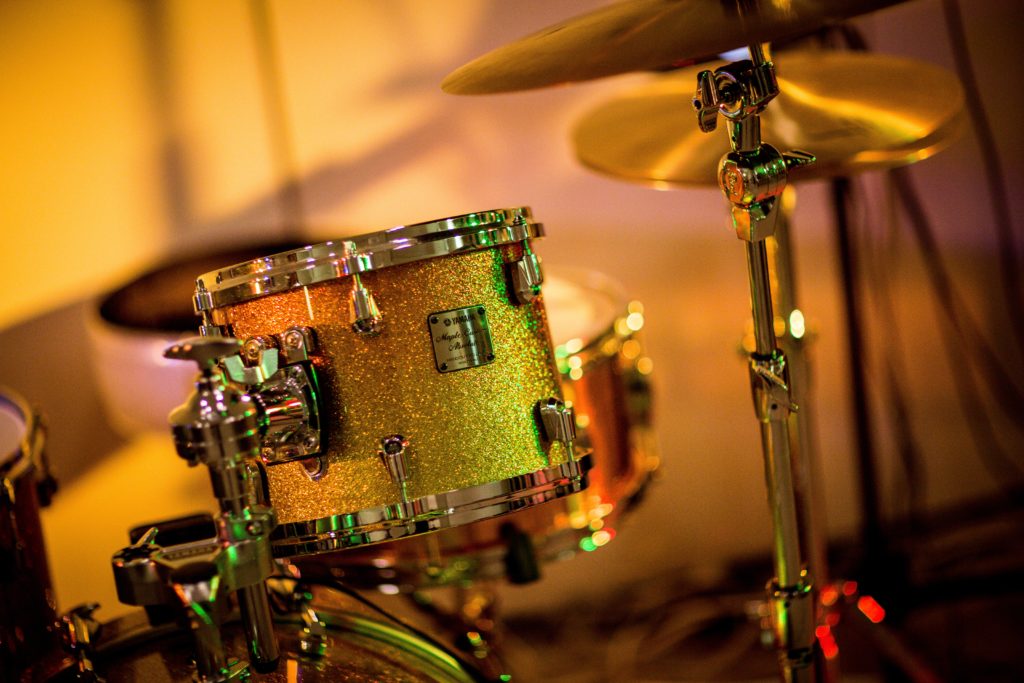
Every musician loves overcoming a challenge, and with drumming, a challenge is more than a sore throat or blisters from plucking strings. It takes a toll on your entire body—legs for the kick and hi hat, arms for the snare, cymbals, and toms, neck for headbanging—which means a challenge is as broad as music genres.
Here are five songs to challenge your skills and push your limits as a drummer in a fun, exciting way.
Brianstorm is a powerful opener to Arctic Monkey’s album Favourite Worst Nightmare with a quick and heavy drum beat in the beginning that flies around the kit, transitioning swiftly into the first verse with a rapidfire hi hat that is dizzying to follow. This 2:50 minute song never never slows down, so it can be a great way to test out your arm and wrist strength. Although it seems like a simple enough beat, it’s the speed that truly makes it a fun challenge to tackle.
Starting strong with some double pedal action, this Van Halen song takes funky, offbeat rhythms and meshes them into a high energy classic that is sure to rile up any crowd. Hot for Teacher takes a lot of energy, physically and mentally, in order to power through. Although it might take some time to adjust to two pedals, once you’ve memorized all the stops and pattern changes, it’ll be smooth sailing for you there.
Moby Dick is misleadingly easy at first, with a simple, jazzy tone at the beginning, but its simplicity is what makes it so challenging. It consists almost entirely of drumming, which means you get the spotlight. With sudden, fast movements that are sure to make you trip up during every listen, this Led Zeppelin song gives plenty of breathing room to be creative with your own fills—which in and of itself is a challenge—but also grants you bragging rights if you manage to memorize it.
This Mars Voltas song is bound to make any intermediate drummer have a heart attack out of pure intimidation. A loud, eccentric banger with lots of stops, it becomes simpler in the verse, but maintains that fast-faced energy all the way through. Not to mention Goliath is also over seven minutes long, no doubt testing any experienced drummer’s energy levels with just one playthrough, but is also a satisfying beast to tame.
Another song that leans less on speed and more on disorienting beats that are hard to keep up with, Ticks & Leeches is 8 minutes of rock and metal ups and downs, giving pauses in between verses to grant you a break every now and then before diving straight into another fast, harsh chorus. If you’re a huge Tool fan with enough time to dedicate to learning every second of this, it’s a great song to push yourself to your drumming limits.
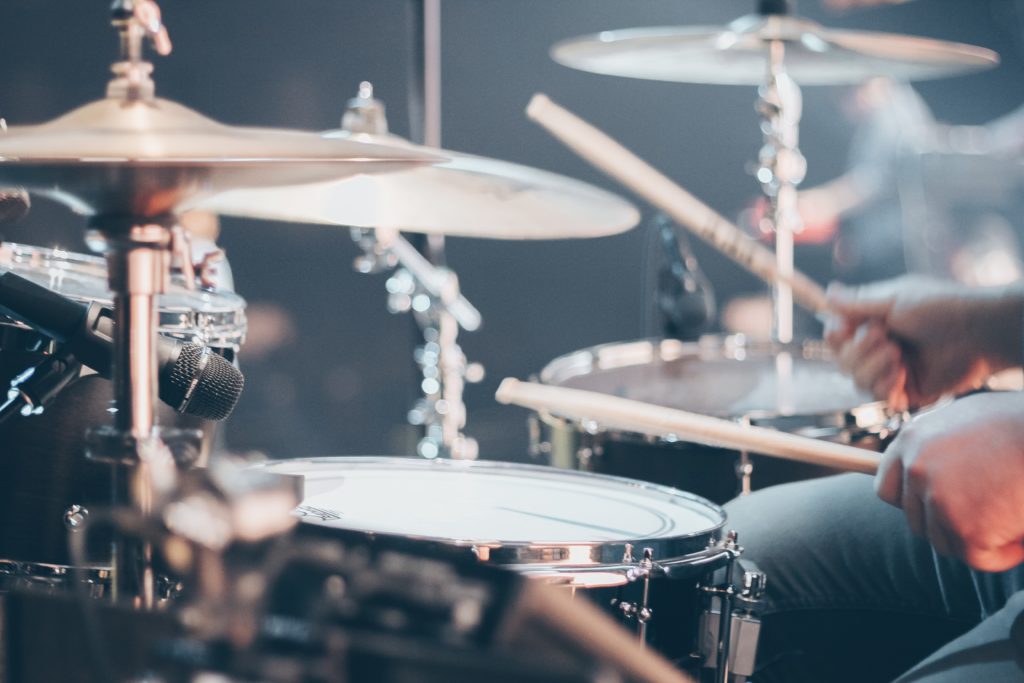
Drumming takes many skills. Not only do you use both hands and feet on a kit, but they’re all most likely going to be doing different things at once. It takes practice to build the skill of rhythmic multitasking, which most drummers won’t have developed when they decide to pick up sticks for the first time.
Here’s five songs for beginning drummers that will help them build up the skills needed for harder songs.
1: Do I Wanna Know by Arctic Monkeys
AM by Arctic Monkeys is full of songs with interesting and tricky drumming patterns that challenge a drummer to use their entire body. The exception, of course, is Do I Wanna Know, which has an easy to follow beat on the kick drum and snare during the verse. While the chorus does add some flare, with a different kick pattern and some high hat, the beat is steady and slow enough for starters to keep up with.
2: Seven Nation Army by The White Stripes
Ah, the dreaded beginner’s song. While every instructor on the face of the earth may be sick and tired of hearing this song, that doesn’t change its simplicity that any new drummer can easily pick up without any prior experience. Sure, your teacher might lose their mind, hearing this song for the thousandth time, but it’s good practice to work up your leg muscle on the kick and teach your hands to do two different things at once.
Dreams, among many other Fleetwood Mac classics, is a great song for any beginner to try out. It has a sweet and mellow vibe that’s easy to keep up with on the kit. Although it’s slightly faster than the other songs on this list, it’s a great way to build up that high hat speed and have fun with new drumming patterns that don’t become too complex. This song also allows you to have some fun with fills and adding ghost notes to the pattern if you feel up to it.
A loud, heart-thumping banger, Buddy Holly by Weezer is the perfect dip-your-toes song for any young rockers eager and ready to go all out without the struggle of a difficult drum beat. It has an easy tone to keep in time with, a slower pace so you don’t lose the tempo, and enough leeway to use the space and play any funky little drum fill that your heart desires.
5: Psycho Killer by Talking Heads
This classic by the Talking Heads is one that everyone should learn purely for its funky bass, catchy guitar stings, and of course, the heart of the song: the drum beat. Although it’s nothing too difficult for a beginner, Psycho Killer leaves plenty of room to experiment with patterns, drum fills, and anything else your heart desires. And, if you’re feeling particularly experimental, try and play Cage the Elephant’s cover of this iconic song.
Electric Guitar

There are many brands you can start off with for electric guitars, and they are all similar in quality at the entry-level; however, three brands have stood the test of time, and you can’t really go wrong with any of these three brands: Fender, Gibson, and Ibanez. Like anything, you will have a good, better, and best option. For electrics, it comes down to where the instrument was made, hands-on craftsmanship, the quality of the wood, and pickups. There are definitely many other options, but these are the prominent features that affect the price. Here is a breakdown of which guitars I would get per level:
Entry Level ($150-400)
Mid Level ($400-800)
Pro Level ($800+)
Now, after you get your electric guitar, one of the next things you’ll be asking yourself is “what kind of amp do I need?” I can tell you, hands down, the Fender Mustang series is the PERFECT practice amp. It’s literally all you need…so much so, that it is the official practice amp of the Freeway Music locations. One of the best ways to ensure that you get all you need is to purchase a package. So, let’s get that out of the way and talk about it. Here are some packages our friends have at Sims:
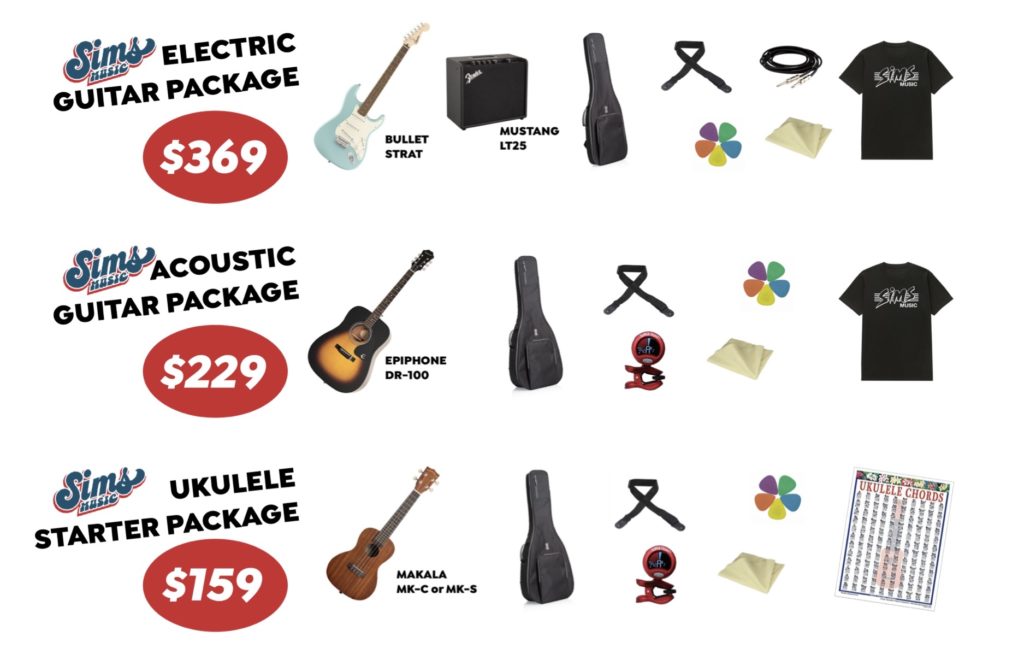
Acoustic Guitar
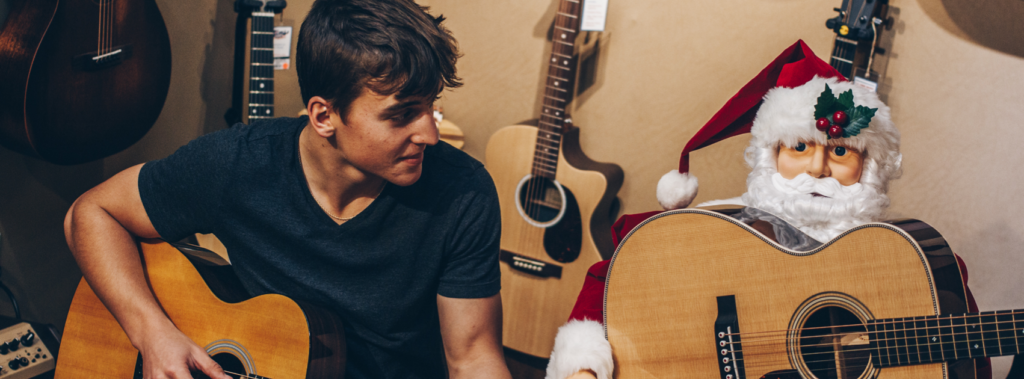
The good, better, best for acoustics is generally found in how much solid vs. laminate wood is involved. Entry level guitars tend to have a laminate top and back and sides. Mid-level acoustics have solid tops. The reason they do the top is because that’s where most of your sound resonates. So, if you have a solid top, it makes a difference. Pro-level guitars are generally solid all the way around with solid tops, sides, and backs. For the most part, you’ll run into the usual suspects for guitars. Here are some recommendations for various guitars at each level:
Entry Level ($150-400)
- Fender FA-15 (3/4 size guitar great for a smaller student)
- Fender (pretty much any)
- Ibanez (pretty much any)
Midlevel ($400-800)
Normally, I’d tout Martin and Taylor pretty hard in this range…especially the Taylor GS mini as it’s literally the perfect 3/4 guitar, but they are low in stock. So, I’d check out the Ibanez Artwood Series. They are great mid-level guitars.
Pro level
Can’t go wrong with Martin, Taylor, Gibson. They are king.
Ukulele
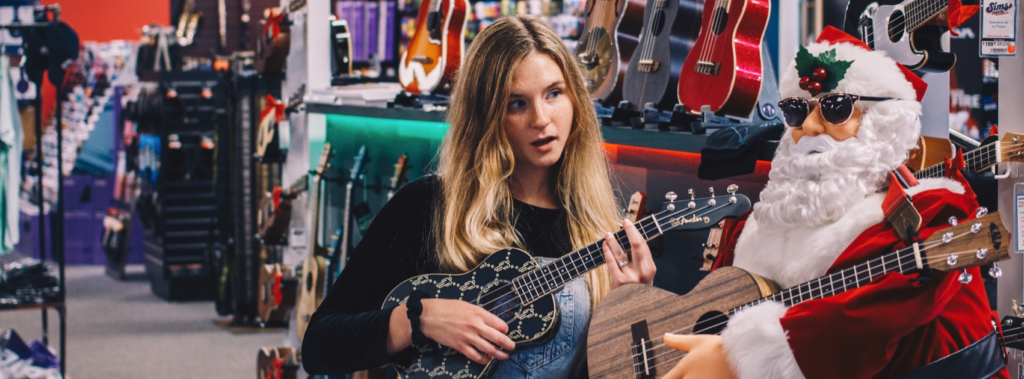
Ukes make for AMAZING holiday gifts because they are portable, easy to learn and play, and very affordable. Ukes tend to range between $50—$300, but float around that $50-150 mark for decent ones. Here are some brands to check out:
- Kala
- Cordoba
- Ortega *This is a newer brand that Sims recently started carrying. They look, sound, and play amazing. I just bought one for Sara Ann for Christmas. Don’t tell her ;)…She’s not reading this is she? :/
Keyboards/Pianos

So, if you’re looking for a serious acoustic piano, check out our friends at Rice Music House. They’ve got a great selection of acoustic pianos and will be of great help to you. The acoustic pianos at Freeway Music are from Rice. You can buy or rent.
If you are in the market for a Digital Piano, I like the Casio and Yamaha brands. You can’t go wrong either way. We stock the Casios at Freeway for our voice lessons.
There are also a slew of portable keyboard options available.
Percussion/Drums
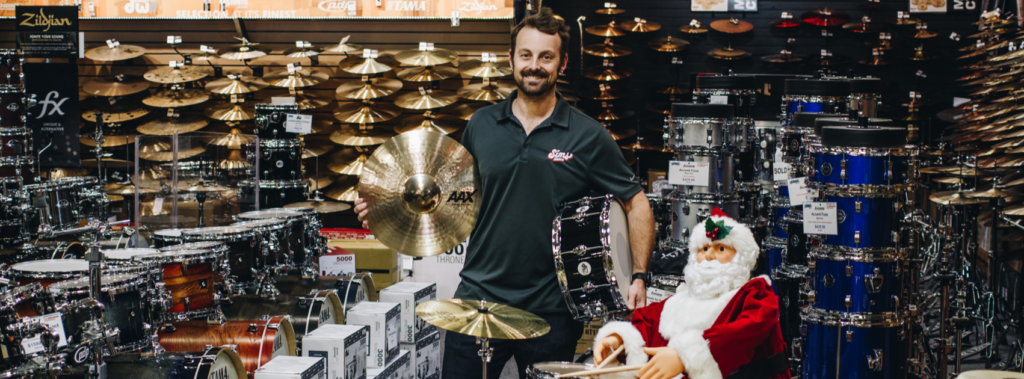
Okay, I JUST started playing drums…so, give me a little grace in this department. It’s okay, I spoke with Justin at Sims, and he is an expert…so we will be alright! Here are some opinions of ours:
Entry Level
Ludwig Accent: Drive(full size for 12+) and Fuse (smaller for a younger kid 8-11)
Intermediate
Pro
PDP, DW, Ludwig, Pearl, and Tama are all gonna have solid options. You might want to consider some nicer cymbals at this point from brands like Zildjian and Sabian.
**Side Note: The cajon has been a popular instrument for drummers as of late for acoustic sets. Check out the LP Americana cajon… it was designed by our very own Justin Sims! 🙂
Recording

So, you wanna ease into recording. The best way to get started is by grabbing one of the Scarlet Focusrite Packages They have two different ones. Both come with a mic, mic cable, headphones, and an intro version of Protools. The only difference is one is solo and has one channel ($219), and the other is a duo with two channels ($269).
Stocking Stuffers
There are a ton of accessories such as capos, tuners, string winders, polish, cables, slides, pedals, shakers, tambourines, sticks, picks, and most importantly…Music Lessons! 😉
Whew…That was a lot of information. I hope this was helpful and Happy Holidays from the Freeway Family! 🙂
Recently, one of our Freeway Music rock band classes was opening up for a band from Nashville called Dedsa. They were great guys that watched and supported every student. They complimented what we were doing with our students. One thing really stood out though. The manager said, “I really love that you are teaching you students stage etiquette!” It never really occurred to me to focus on that. I just shared it with our music students as practical advice. So, here are a few things that could improve your performance etiquette.
1. Give Props
Always give props to the bands that have played before you and the ones that will play after you, even if the bands don’t return the favor. It’s important to have the reputation of being supportive. Sometimes people didn’t catch the name of the last band. It also encourages your friends who came to see your band to stick around and check out the next band. Almost always, the other band will return the favor and give you props to their fans. Also, give props to the venue and its workers.
2. Listen
Whether headlining or opening, get out there and listen to the other bands, even if just for one song. Don’t be the “diva” band that is too good to get out and listen to the opener. At the same time, don’t be the band who plays and rolls. A music community needs to support each other. The bar for the level of support should start at the top with the musicians who are actually playing. Don’t set it low; lead by example!
3. Never Assume
Don’t assume anything, but be clear and communicate in advance. This applies to sharing gear, set time, sound check, the money breakdown, etc. Always iron out all details before the gig happens.
4. Sound Check
I could probably write a whole blog on soundcheck alone. Follow these three P’s: be punctual, prepared, and polite. Come to the venue on time or early. Have all the gear you need there and ready to move on stage. Cooperate with the sound guy and let him run the show. Whatever you do, don’t noodle incessantly or try to showcase your skills to the bar. Testing your gear for tone and volume is one thing, but everyone hates a “noodler.”
5. Moving Gear
If you aren’t a rockstar touring with roadies, don’t act like it. When you are finished, get your gear off stage as quickly as possible, as to help the other band get on. I like to offer to help bands move their gear on and off, whether I am opening or headlining; however, never assume that someone wants help. Some people are weird about other people touching or moving their stuff. It also can come off as though you are pressuring or rushing a band to get on or off stage. So, always ask!
6. Don’t Abuse Perks
If a place gives you one guest member per band, don’t try to stretch it or sneak people in. It’s their policy and they have a business to run. Again, don’t act like a rockstar when you aren’t. This applies to anything such as beverages or food. Don’t try to use your tab for friends or abuse how many beverages your or your band are drinking, as to leave none for the other band or band members.
7. Market Your Show
Blast the event on social media. Email your contacts and let them know about the event. Text everyone that you think might want to come. Put out posters. In general, just get the word out. It WILL make a HUGE difference. The club/venue owners will notice.
8. Be Cool
This sounds simple, but it’s so easy to screw this one up. Simply, be cool to other bands, the venue employees, fans, etc. Develop relationships with them. You will be surprised how this helps the future of your career.
9. Be Positive on Stage
It’s a blessing to be able to play and a blessing to share that with others. If that’s not your attitude, you are in the wrong business…move on! Whether or not you enjoy a gig is entirely up to you! Your energy will bleed over into your bandmates and the crowd. I’m always more impressed with guys that play for two people who give it their all, than a guy who plays for thousands and is half-hearted.
10. Do NOT Overreact to Mistakes
Mistakes WILL happen…so how will you react? The best players are “professional mistake cover-uppers.” Learn to take your mistake and make it seem intentional. Use the moments as opportunities for genius. It’s like drawing a three when you wanted to draw a 9. Turn it into a 9! When it happens, let it roll and think forward. NEVER reflect on it and think backwards. Typically, people will react more to your reaction of a mistake, than the actual mistake itself.
I hope these principles sink into you and that you will apply them to your next performance. You have a large responsibility to set the standard and make performances a better experience for everyone.
Check out my blog on Sound Check Etiquette
